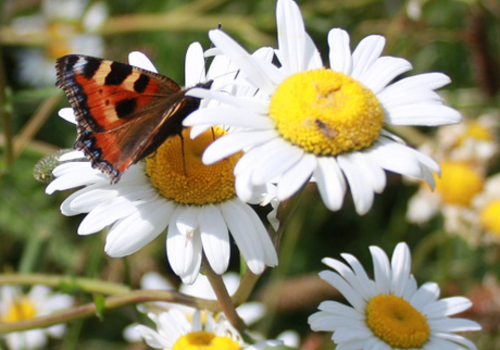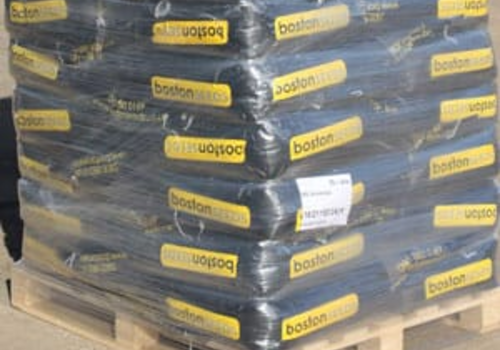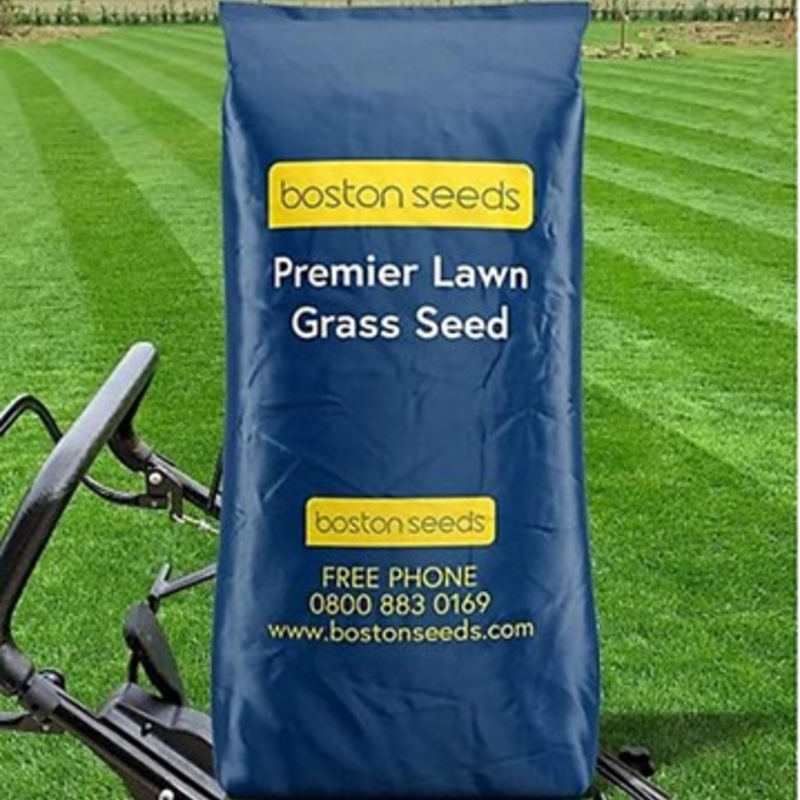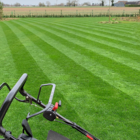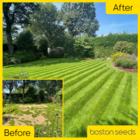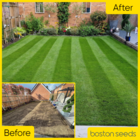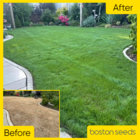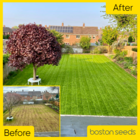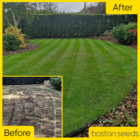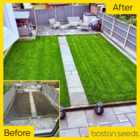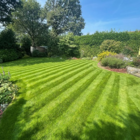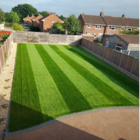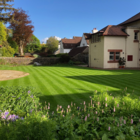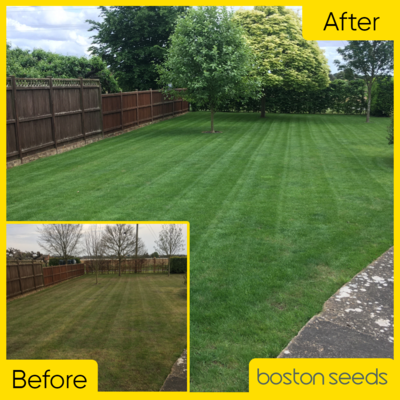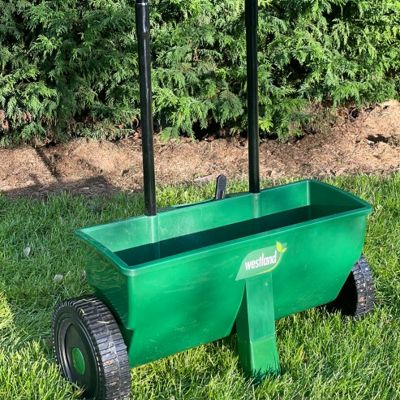BS Premier Lawn Grass Seed
For a superior blend of quality grass seed, look no further than BS Premier Lawn Seed - tried, tested and recommended by us. Combines exceptional wear tolerance, fast establishment and a first-class appearance. Utilising outstanding grass varieties usually reserved only for professional sports pitches, this premium grass seed mix is suitable for sowing all year round.
- Combines a dense, tough and durable sward with a fine-leaved, premium appearance.
- Very quick to germinate and establish.
- Perfect for overseeding and new lawns (all images are actual photos of BS Premier Lawn Seed new lawns and renovations).
- Contains: 80% amenity perennial ryegrass (2 exceptional varieties from the top third of the Sports Turf Research Institute's recommended list), and 20% slender creeping red fescue.
- DEFRA-certified for exceptionally high purity and germination.
- Sow at 50 grams per sq/m - 20kg covers 400 sq/m.
- For best results, use with our pre-seeding fertiliser and a spreader.
Mixture Specification
Premium Grass Seed Specification
What is in premium lawn grass seed? BS Premier Lawn Grass Seed combines the highest quality Dwarf Amenity Perennial Ryegrass varieties with the finest-leaved fescue to create a truly exceptional lawn.
80% Dwarf Amenity Perennial Ryegrass
- 2 quality varieties, selected from the top third of the Sports Turf Research Institute’s recommended list for use on lawns and sports pitches.
- High shoot density, fine-leaved and year-round colour.
- Quick to establish and rapid recovery from wear and tear.
20% Slender Creeping Red Fescue
- Exceptionally fine-leaved fescue, recommended by the Sports Turf Research Institute for high-quality lawns and summer sports surfaces.
- Horizontal, creeping growth to fill the bottom of the sward and create a thick, dense turf along with the Dwarf Amenity Perennial Ryegrass.
Sowing & Establishment
How to sow a new lawn with BS Premier Lawn Grass Seed
1 - Clear the area
Clear the area and remove any stones, weeds and other debris.
2 - Improve the soil
Cultivate the area to a depth of 15cm and remove any debris that is unearthed. For heavy clay soils, optionally, mix in sharp sand.
3 - Create a level seed bed
Level and rake over the area. Use a lawn roller to firm the soil, if required.
4 - Allow the soil to settle
If possible, leave the soil for a week to allow a flush of weeds to come through; remove before sowing.
5 - Final ground preparation
Rake the area to loosen the top layer of soil. Apply our Pre-Seeding Lawn Fertiliser and rake into the soil.
6 - Sowing the grass seed
Spread the grass seed evenly across the area at 50g/sqm. A spreader can be used for accurate application.
7 - Rake and roll
This step is essential for successful establishment. Gently rake over the area again to incorporate the seed into the top 1-2cm of the soil, so that there is very little seed still visible on the surface. Then lightly roll or tread the seeds in to ensure good seed-to-soil contact. A harrow can be used for large areas.
8 - Water
If going through a period of drought, water the area every other evening for the first few weeks. If regular rainfall, manually watering will not be necessary.
9 - Mowing the lawn
Under optimum conditions, the seed should germinate within approximately 10-14 days. Once it reaches 3-4 inches, cut the lawn for the first time, gradually lowering the height with each subsequent cut as desired.
How to repair an existing lawn with BS Premier Lawn Grass Seed
1 - Prepare the grass
Cut the existing grass short and almost scalp the lawn with the lawn mower. Remove any dead grass, debris and thatch.
2 - Improve the soil
Scarify or rake the surface to loosen the top layer.
3 - Aerate the lawn
Optionally, to aid drainage, use a garden fork or aerator to create small holes of around 1-2 inches deep.
4 - Sow the grass seed
Spread the grass seed evenly across the area at a minimum of 25g/sqm. A spreader can be used for accurate application.
5 - Rake and roll
This step is essential for successful establishment. Gently rake over the area again to incorporate the seed into the top 1-2cm of the soil, so that there is very little seed still visible on the surface. Then lightly roll or tread the seeds in to ensure good seed-to-soil contact. A harrow can be used for large areas.
6 - Water
If going through a period of drought, water the area every other evening for the first couple of weeks. If regular rainfall, manual watering won’t be needed.
7 - Mowing the lawn
Under optimum conditions, the seed should germinate within approximately 10-14 days. Once it reaches a height of 3-4 inches, cut the lawn for the first time, gradually lowering the height with each subsequent cut as desired.
Maintenance
Maintainance For Premium Lawns
1 - Germination
The best time to sow our Premier Lawn Seed is from March-October, when the soil temperature is around 8-10 degrees. Under optimum conditions, the seed should germinate within 10-14 days from sowing.
2 - Watering
Grass seed requires warmth, moisture and light to germinate. Typically, autumn will provide more favourable conditions for sowing in terms of moisture, however, if there is a period of drought, manually watering the seeds will be beneficial – this can be done every other evening to allow the moisture to soak into the soil.
3 - Mowing
Allow your lawn to grow to around 3-4 inches in height before cutting your lawn. This can be reduced by half an inch each time until you reach the desired height. An established lawn sown with our Premier Lawn Grass Seed can be cut as low as 20-40mm. It is important to remove the grass cuttings as dead grass will prevent sunlight from getting to the new grass.
4 - Fertilisation
Regularly fertilising your lawn will provide it with the nutrients it requires to stay lush and green all year-round.
Once the lawn is four months old, you can apply our quick release fertilisers. Dependent on the time of year, choose our Spring and Summer Fertiliser or Autumn and Winter Fertiliser. Around four applications a year, with a minimum of three months between applications will provide sufficient nutrients for an established lawn.
5 - Scarifying, Aerating and Overseeding
Both autumn and spring are good times of year to aerate and scarify your lawn, and tackle any worn areas by overseeding. Aerating your lawn is optional, but particularly useful if you have heavier clay soils where waterlogging may be a problem. Use an aerator or a garden fork to aid drainage. Scarifying is also beneficial in removing any dead grass, moss and thatch that may be hindering the growth of your existing grass.
After this process, there may be some bare patches amongst your lawn – this is the perfect time to overseed when the soil temperature is optimum and moisture is plentiful. We recommend overseeding with the same grass seed mixture as you have previously sown for a uniform appearance.
6 - Controlling Weeds
Unfortunately, as comes with seedbed preparation, weed seeds can lay dormant in the soil and it’s not until they are disturbed and the conditions are ideal, that they then can start to germinate.
If you find that weeds appear during establishment, these will generally be taken out by regular mowing once the lawn has reached around 3-4 inches in height. If the weeds are recurring, after 4 months, a Selective Weedkiller can be applied which will kill common lawn weeds, whilst leaving the existing grass unharmed.
7 – Controlling Moss
Moss can become problematic in areas that are particularly damp and shady. Moss Killer is best applied during March-October when moss is actively growing.
On a newly established area (under 5 months old), avoid using a moss killer as this will be too strong for the lawn. Instead, rake over the area to loosen and remove the moss and add further seed if required.
Once the lawn is established (over 5 months old), a moss killer can be applied such as our Lawn, Feed and Weed plus Moss Killer for light areas of moss, or our Lawn Revivor and Moss Destroyer for more heavily infested areas. After using these, the moss will turn black within a couple of weeks, rake and remove this and overseed with one of our lawn seeds.
FAQs
How to choose the Right Quantity of Premium Grass Seed?
Whether you're just looking for grass seed for a small patch or land or looking for large quantities for landscape projects we have a wide range of sizes. At Boston seeds you can buy our premium grass seed in multiple sizes including 2kg, 5kg, 10kg and 20kg.
If you're growing a lawn from scratch but unsure how much grass seed you need, our handy Grass Seed Calculator can help you.
What are the Benefits of Using High-Quality, Premium Grass Seed?
Using high-quality grass seed can have numerous benefits for your lawn. Here are some of the advantages of using premium grass seed:
- Improved Germination Rates: High-quality grass seed has a higher germination rate, meaning more seeds will germinate and grow into grass, giving you a greener, fuller lawn.
- Increased Durability: Premium grass seed is more resistant to wear and tear from use, keeping your lawn looking great even with heavy foot traffic and other forms of stress.
- Better Disease Resistance: High-quality grass seed is more resistant to diseases, which reduces the risk of common lawn ailments and keeps your new lawn healthy.
- Enhanced Appearance: Premium grass seed produces a lush, green lawn that looks great.
- Increased Property Value: A well-manicured, good quality lawn can boost your property value, making it more attractive to potential buyers if you decide to ever sell.
Why choose BS Premier grass seed over normal grass seed?
This premium grass seed is the best type of seed for use for ornamental lawns that still need to be suitable for families and modern life. When you want your lawn to look its best - choosing BS Premier grass seed is perfect. It combines exceptional wear tolerance, speed of establishment with a first-class appearance.
Is it worth buying premium grass seed?
It will completely depend on your needs and requirements, but this mix does more than just deliver a fantastic appearance. When buying grass seed it is important to buy for use rather than just looks.
Our premium grass seed has better genetics using superior varieties, meaning a greener and healthier grass plants, better disease resistance and excellent resistance to wear and tear. Our BS Premier Lawn Grass Seed combines a dense, tough and durable sward with a fine-leaved, premium appearance making it perfect for overseeding or sowing a new lawn anytime of the year.
When should I sow premium grass seed?
Our BS Premier grass seed can be sown all year round and will create a beautiful, lush green lawn - although avoid the cold winter months wherever possible.
Is premium grass seed harder-wearing?
Premium grass seed has exceptional wear tolerance, containing grass varieties usually reserved for professional sports pitches, including top level winter sports clubs such as football and rugby. This means that BS Premier grass seed will keep your lawn looking great even after intense or continuous use from children and pets.
What to Look for When Buying Premium Lawn Grass Seed?
When buying premium lawn grass seed, there are several factors to consider to ensure you get the best results for your lawn.
Here are some key things to look for:
- High-Quality Grass Species: Opt for grass seed mixtures that include high-quality grass species such as perennial ryegrass, red fescue, and creeping bentgrass. These grass varieties are renowned for their durability and ability to withstand heavy use, ensuring a resilient and lush green lawn.
- Optimal Germination Rates: Choose a grass seed that has high germination rates even under normal conditions. This ensures your lawn will grow quickly and evenly, giving you a beautiful, uniform looking lawn.
- High Quality Mixture: A good, high-quality mix of different grass types can create a lawn that is not only lush and green but also resistant to diseases and pests. This diversity in your grass seed mixture can lead to a healthier, more robust lawn.
- Easy to Maintain: Choose a grass seed mixture that is easy to maintain. This will save you time and effort overtime, allowing you to enjoy your lawn without constant maintenance and upkeep.
How to Choose the Best Grass Seed for Your Lawn?
Choosing the best grass seed for your lawn can be a daunting task, especially with the numerous options available on the market. However, by considering a few key factors, you can make an informed decision that suits your specific needs.
Here are some tips to help you choose the right grass seed:
- Sunlight Exposure: How much sunlight does your lawn get? If your lawn gets lots of sun, opt for a grass seed that’s tolerant of high temperatures and drought. For partially shaded areas, choose a premium shade grass seed that thrives in lower light conditions, for example under trees or by hedges. Read our blog on how to grow grass in shady areas.
- Intended Use: Consider how you plan to use your lawn. For families with kids or pets, select a grass seed that’s durable and resistant to wear and tear - making premium grass seed a great choice. This ensures your lawn remains lush and green despite heavy foot traffic.
- Soil Quality: Assess the quality of your soil. For clay-based soils, choose a grass seed that can handle wet conditions. If your soil is sandy, look for a drought-tolerant grass seed mix.
- Desired Appearance: Decide on the look you want for your lawn. If you aim for a luscious, green lawn, select a grass seed high in nitrogen and phosphorus to promote vibrant growth.
By considering these factors, you can choose a grass seed that’s tailored to your specific needs and will help you achieve the lawn of your dreams. Read our blog on how to choose the best grass seed.
Buy With Confidence

